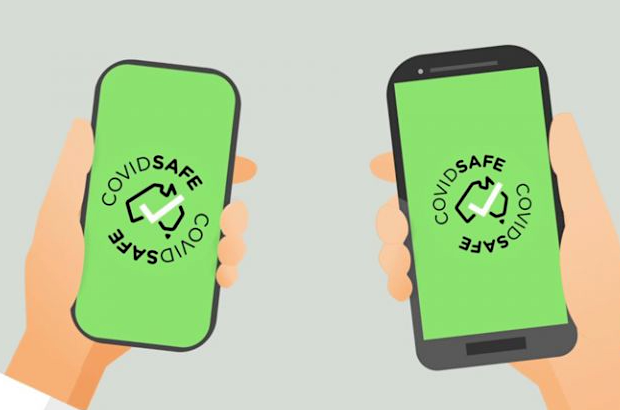

“Pretty much all my friends who are disabled and chronically ill are using the app. Pretty much all my friends who work in tech, especially the security side of tech, are NOT using it.”- AHP panellist
For May 2020, Australia’s Health Panel (AHP) asked panellists about their first impressions of and attitudes towards the COVIDSafe smartphone app released by the Australian Government in April 2020.
Overall, 165 panellists participated in this survey. Just over half (51%, n=83) had used the COVIDSafe app and an additional 7% (n=11) had downloaded it but were yet to use it. This is a noticeably higher download rate of the COVIDSafe app than the general population, which currently is reported to be just over 6.4 million people(link is external) or around one quarter of the Australian population.
The majority of panellists were female (73%, n=117), aged 46 or older (83%, n=132) and lived in major cities with more than 250,000 people (67%, n=105). There was a broad spread of panellists across every state and territory (see Figure 1). It is unclear if any of these demographics contributed to the higher download rate of the COVIDSafe app compared to the general population. It is also possible that the higher rate of COVIDSafe app usage stemmed partially from the panellists being a cohort who are more highly engaged with health issues than the general population.
figure_1.png
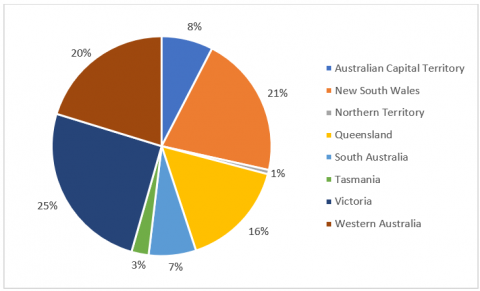
However, despite the high rate of COVIDSafe downloads amongst those who completed the survey, as a cohort the panellists had a broad spread of views about the app with a majority agreeing on only a few questions. The only points of clear, overall agreement were that most panellists (80%, n=125) believed that the COVIDSafe app should be voluntary not mandatory and 77% (n=12) believed that the Government should publicly report all uses of the data. Beyond that the Panel appeared to have very mixed views on the COVIDSafeFigure 1- State/Territory of residence of panellists who participated in the COVIDSafe survey app.
figure_2.png
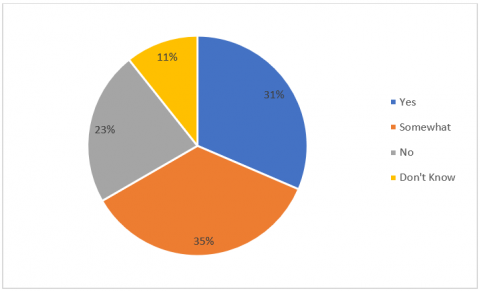
Only 31% (n=50) of people believed that the name “COVIDSafe” accurately reflected what the app does (see Figure 2), with a further 35% (n=56) thinking that the name was ‘somewhat’ accurate.
Only 35% (n=56) believed that the app would help counter COVID-19, while 45% (n=72) believed that it could somewhat help counter COVID-19. This indicates some confidence in the community about the app’s usefulness if not the accuracy of the name. Despite this belief in the potential effectiveness of the app, the panellists had a mixed response to the idea of relaxing social distancing restrictions due to app usage. Only 26% (n=41) agreed that restrictions should be relaxed, while 37% (n=58) thought that maybe they should be relaxed and 32% (n=51) believed that they shouldn’t be relaxed based on use of the COVIDSafe app (see Figure 3).
figure_3.png
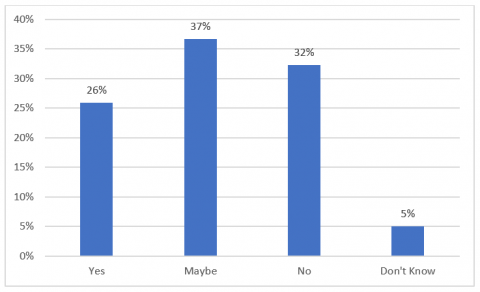
When asked to describe how the COVIDSafe app worked, panellists gave a broad range of responses. Some common ones included:
-
Many panellists stated that the app improved “contact tracing”, either by making it “faster” or “more efficient”, multiple others reported that it worked by “tracking people’s movements”.
-
Very few panellists were able to articulate the minimum distance or time requirements for the COVIDSafe app to register a contact.
-
Some panellists were confused as to whether the app itself would alert you to possible exposure or would allow the health authorities to contact you.
-
Concerningly some thought that the app had additional functions such as “notify you of definitively being infected” or “tracking non-symptomatic carriers in the community”.
-
Panellists reported some confusion about what the app would do if they were positively diagnosed, with some believing it would contact all their phone contacts or the ones they had been physically close to.
There were also a number of panellists who reported that they believed the COVIDSafe app did not work, citing a range of technological issues with how the app was designed/implemented that they believed made it non-functional and could worsen the situation. As one panellist put it:
“I think this app is likely to be a net negative, given the misunderstanding the public has about the app. It will give people a false sense of security and encourage them to stop taking appropriate measures. At the same time, the efficacy of the app is completely unproven. I fear it is not a replacement or improvement over traditional contact tracing (even if it were mandatory). As a computer systems engineering professional I see this a lot - rushing to try and fix a problem with a technological band-aid that doesn’t work because it didn’t address any of the underlying problems...”
Many of the misunderstandings expressed by respondents appear to stem from the choice of language used to promote COVIDSafe with some of it being unclear or having multiple possible meanings. For example, the word ‘contact’ when used in the context of a phone typically refers to a person’s address book of contact information, making ‘contact tracing’ a potentially confusing term in regard to a phone-based function. Similarly, ‘notifications’ in the context of phone apps has an established meaning distinct from how the COVIDSafe app would allow health authorities to ‘notify’ them in the event of possible exposure. Meanwhile there was clear confusion between the difference between ‘tracking’ and ‘tracing’.
This reinforces the need for clear communication and appropriate terminology from authorities on health matters, as it is possible that the confusion in terminology may lead to consumer and community misunderstanding of the details of how the COVIDSafe app works and taking a different position on using the app than they otherwise would have.
While a slight majority of respondents found the information on the Department of Health’s website either very useful (20%, n=31) or somewhat useful (34%, n=54) in deciding whether or not to use the COVIDSafe app, a significant minority (40%, n=63) reported that they didn’t use that information to make their decision. Given the mixed understanding from respondents as to how the COVIDSafe app actually works, this suggests that there is scope to improve both the website content and website awareness to allow for greater understanding of the app details by consumers. Additionally, given the number of people who did not use the Department of Health website, the process that consumers follow to download the COVIDSafe should be reviewed to ensure that it provides sufficient, accurate and understandable information to consumers as the only guaranteed interaction for those downloading the app.
figure_4.png

Panellists were evenly split when asked whether they were worried about risks to their personal privacy with 49% (n=77) saying they were worried or somewhat worried while 49% (n=78) were not worried. Very few respondents (20%, n=31) trusted the Government to be able to securely store and protect the data gathered by the COVIDSafe app, with 22% (n=35) having some level of trust and 41% (n=64) not trusting the Government at all (see Figure 4). A slight majority of panellists also expressed that they were concerned (35%, n=55) or somewhat concerned (22%, n=35) about the Government using the COVIDSafe app data for purposes not related to COVID-19 tracing.
When asked who they would trust more than the Federal Government, panellists suggested a wide range of options. Health organisations such as the AMA or RACGP, research organisations like universities or the Grattan Institute, consumer organisations like the CHF, tech companies such as Apple or Google, government agencies like the Australian Digital Health Agency (ADHA) and the various state governments and health authorities were common answers. Some respondents specifically highlighted the use of Amazon Web Services as the reason they did not trust the system set up by the Federal Government to protect their data, while others indicated that they would trust any other group more than the current Federal Government to protect their data and privacy. This would suggest that the Government should embed some of these more trusted organisations into the project governance structure to increase the acceptability of the COVIDSafe app and other data related projects amongst the Australian populace.
figure_5.png
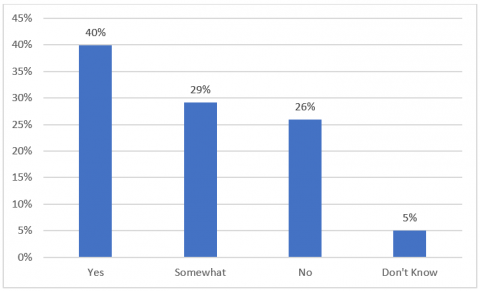
Panellists expressed some worry about future updates of the COVIDSafe app expanding the app’s functions beyond what they believed was acceptable, with 40% (n=63) being worried and 29% (n=46) being somewhat worried (see Figure 5). They were split when asked if it was appropriate for the COVIDSafe app to have been launched before relevant legislation had been passed. 34% (n=53) agreed that it was appropriate, 18% (n=29) thought that maybe it was and 46% (n=72) did not think it was appropriate. Panellists were not very confident that there was enough independent oversight to ensure the app and its data were used and stored appropriately. 18% (n=28) were confident there was independent oversight, 37% (n=59) were somewhat confident and 45% (n=71) were not confident at all (see Figure 6).
These findings further highlight the lack of trust consumers appear to have with the Government doing what they say they will and not broadening the use of the data at a future point. Responses suggest that most consumers want some level of external scrutiny to reassure them that the Government is acting appropriately and in line with what they had promised.
figure_6.png

Finally, given the clearly mixed views expressed by panellists on the COVIDSafe app, the respondents were segmented into clusters to determine if there were potential separate subpopulations with differing attitudes. Respondents were segmented into two groups: those who had indicated they had or would download and use the COVIDSafe app and those who would not. Those who reported they did not have a smartphone were excluded.
Re-analysing the response data revealed, perhaps unsurprisingly, significant differences between these two groups as indicated in Table 1. Those who were willing to use the app were more likely to believe the name was accurate, believe that the app would help counter COVID-19 and trust the Government to securely store and protect the data. In contrast, those who had not downloaded and used the app were more worried about the risks to their privacy, more concerned about the app data being used for non-COVID purposes, worried about future expansion of the app functions, did not believe releasing the app before legislation was passed was appropriate and were not confident there was sufficient independent oversight.
Table 1- Breakdown of panellists responses by group segmentation of download and use of app vs non-download and use of app.
|
Question |
Have downloaded/used app |
Have not download and used the app |
|
Do you think the name "COVIDSafe" accurately reflects what the app does? |
Yes (46%) Somewhat (44%) |
Somewhat (23%) No (43%) |
|
Do you think the COVIDSafe app can help counter COVID-19? |
Yes (60%) Somewhat (38%) |
Somewhat (55%) No (25%) |
|
Do you believe that use of the COVIDSafe app should allow for some relaxing of social distancing provisions? |
Yes (38%) Maybe (41%) |
Maybe (36%) No (48%) |
|
Are you worried about risks to your personal privacy from using the COVIDSafe app? |
No (72%) |
Yes (55%) Somewhat (30%) |
|
Are you concerned about the COVIDSafe app data being used by the Government for purposes not related to COVID-19 tracing? |
No (61%) |
Yes (61%) Somewhat (25%) |
|
Do you trust the Government to be able to securely store and protect the data gathered by the COVIDSafe app? |
Yes (33%) Somewhat (43%) |
No (77%) |
|
Do you believe it is appropriate for the COVIDSafe app to be launched and to begin to collect data before legislation has been passed? |
Yes (54%)
|
No (79%) |
|
Are you worried that future updates to the COVIDSafe app may expand the functions of the app beyond what you believe are acceptable purposes? |
Somewhat (34%) No (44%) |
Yes (73%) |
|
How confident are you that there is enough independent oversight to ensure that the COVIDSafe app and its data are being used and stored appropriately? |
Very confident (31%) Somewhat confident (51%) |
Not confident at all (82%) |
Given the stark contrast between these two segmented groups, this indicates that it may not be the case that the Australian public is largely undecided on the COVIDSafe app as the initial results suggest but rather that the broader public is made up of at least two distinct groups who have quite strongly held and opposing attitudes towards the COVIDSafe app. Those differing attitudes have resulted in differing decisions about whether to use the app or not. This suggests that while the Government’s COVIDSafe initiative was designed in a way that was well received by a section of the Australian public, another section of the population had fundamental issues with the initiative that resulted in them rejecting it. Given the need for whole-of-population support for Government health measures and initiatives to be successful, particularly in a pandemic context, this apparent split in the population could be a significant barrier to the app achieving its maximum potential benefit.
In summary, this survey on Australia’s Health Panel suggests that Australians are very mixed on the use of the COVIDSafe app, only agreeing that the app should be voluntary and the uses of its data should be public and transparent. On all other issues with the app the public seems to be split into two groups, with one group appearing to be motivated by a desire to counter COVID-19 and the other being motivated by a distrust of the Federal Government. While the relative sizes of these groups can’t be accurately judged from this survey, the failure of the COVIDSafe app to reach the targeted usage rate of 40% of the population suggests that the latter group is sufficiently large to hamper the ability of such Government health initiatives to be fully effective. In addition, given the nature of Australia’s Health Panel there is potentially a third sub-group of people within the broader populace who are apathetic or not engaged on health issues who were not captured in this survey whose disengagement with the COVIDSafe app may have impacted its download and use levels.
As we move into a post-COVID-19 world and accept that some form of contact tracing will be part of the “new normal” for some time to come, based on this Australia’s Health Panel survey CHF would recommend that the Australian Government prioritise improving the level of trust the community has in it, in particular in relation to the appropriate and safe use of personal data, so that future health initiatives are able to get the widespread community support and buy in necessary for them to succeed.
“I would like to see this app broadened and independent authority established to be used as a general epidemic app so that it can be activated to monitor any epidemic/pandemic. Look at how influenza cases are down due to our social distancing and hygiene practices. I would like to see the gatekeepers of the app as the independent expert epidemic management authority. It would be govt funded but they would need to request access to data - not instigate new functions/purposes.”
- A member of Australia’s Health Panel.
The Consumers Health Forum of Australia would like to thank all panellists for giving their time to participate in this survey. Any questions about this survey and its findings can be directed to info@chf.org.au.
Note: as each question in the AHP survey was optional, the number of responses for each question varies across the survey. As such the total ‘n’ for the set of answers of each question may not add up to the same overall number of survey participants.
